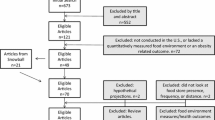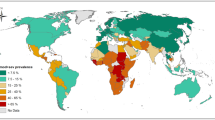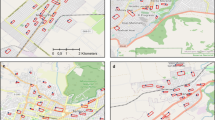Abstract
Obesity in the sub-Saharan Africa region has been portrayed as a problem of affluence, partly because obesity has been found to be more common in urban areas and among the rich. Recent findings, however, reveal rising prevalence among the poor particularly the urban poor. A growing body of literature mostly in Western countries shows that obesity among the poor is partly the result of an obesogenic-built environment. Such studies are lacking in the African context. This study examines the characteristics of the local food environment in an urban poor setting in Accra, Ghana and further investigates the associated risk of obesity for residents. Data on the local food environment was collected using geographic positioning system (GPS) technology. The body mass indices (BMI) of females (15–49 years) and males (15–59 years) were calculated from measured weight and height. Data on the socio-demographic characteristics and lifestyle behaviors of respondents was also collected through a household survey. Spatial analysis tools were used to examine the characteristics of the local food environment while the influence of the food environment on BMI was examined using a two-level multilevel model. The measures of the food environment constituted the level 2 factors while individual socio-demographic characteristics and lifestyle behaviors constituted the level 1 factors. The local food environment in the study communities is suggestive of an obesogenic food environment characterized by an abundance of out-of-home cooked foods, convenience stores, and limited fruits and vegetables options. The results of the multilevel analysis reveal a 0.2 kg/m2 increase in BMI for every additional convenience store and a 0.1 kg/m2 reduction in BMI for every out-of-home cooked food place available in the study area after controlling for individual socio-demographic characteristics, lifestyle behaviors, and community characteristics. The findings of this study indicate that the local food environment in urban poor Accra is associated with increased risk of obesity through providing access to convenience stores. In order to reduce the risk of obesity in these urban poor communities, there is the need to regulate the availability of and access to convenience stores while also encouraging healthier offerings in convenience stores.


Similar content being viewed by others
Notes
Boiled rice stir-fried with vegetables, sausage and eggs
Rice and beans boiled together
Rice cooked in tomato sauce
A pounded starchy staple made from plantain and cassava
Cooked corn and cassava dough
Steamed corn dough
References
World Health Organization. Controlling the global obesity epidemic. Available at http://www.who.int/nutrition/topics/obesity/en/. Accessed 05 Aug. 2015.
Steyn PN, Mchiza ZJ. Obesity and the nutrition transition in sub-Saharan Africa. Ann N Y Acad Sci. 2014; 1311: 88–101.
Caballero B. The global epidemic of obesity: an overview. Epidemiol Rev. 2007; 29: 1–5.
Semba RD. Nutrition and Ophthalmology. Totowa, New Jersey: Humana Press Inc.; 2007: 219–40.
Huang TT-K, Glass TA. Transforming research strategies for understanding and preventing obesity. JAMA. 2008; 300: 1811–3.
Cohen-Cole E, Fletcher JM. Is obesity contagious? Social networks vs. environmental factors in the obesity epidemic. J Health Econ. 2008; 27: 1382–7.
Tremblay A, Perusse L, Bouchard C. Energy balance and body weight stability: impact of gene-environment interactions. Br J Nutr. 2004; 92(Suppl 1): S63–6.
Feng J, Glass AT, Curriero FC, Stewart FW, Schwartz SB. The built environment and obesity: a systematic review of the epidemiologic evidence. Health Place. 2010; 16: 175–90.
Hill JO, Peters CJ. Environmental contributions to the obesity epidemic. Science. 1998; 280: 1371–4.
Popkin BM. The nutrition transition in low-income countries: an emerging crisis. Nutr Rev. 1994; 52: 285–98.
Popkin BM. An overview of the nutrition transition and its health implications: the bellagio meeting. Public Health Nutr. 2002; 5: 93–103.
Voster HH. The emergence of cardiovascular disease during urbanization of Africans. Public Health Nutr. 2002; 5: 239–43.
Vorster HH, Kruger A, Margetts BM. The nutrition transition in Africa: can it be steered into a more positive direction? Nutrients. 2011; 3: 429–41.
BeLue R, Okoror AT, Iwelunmor J, et al. An overview of cardiovascular risk factor burden in sub-Saharan African countries: a socio-cultural perspective. Global Health. 2009; 5: 10.
Ding D, Gebel K. Built environment, physical activity, and obesity: what have we learned from reviewing the literature? Health Place. 2012; 18: 100–5.
Papas MA, Alberg AJ, Ewing R, Helzlsouer JK, Gary TL, Klassen AC. The built environment and obesity. Epidemiol Rev. 2007; 29: 129–43.
Gordon-Larsen P, Nelson CM, Page P, Popkin BM. Inequality in the built environment underlies key health disparities in physical activity and obesity. Pediatrics. 2006; 117: 417–25.
Cummins S, Macintyre S. Food environments and obesity-neighborhood or nation? Int J Epidemiol. 2006; 35: 100–4.
Ali AT, Crowther NJ. Factors predisposing to obesity: a review of the literature. JEMDSA. 2009; 14(2): 81–4.
Reel JJ, Badger BK. From food deserts to food swamps: health education strategies to improve food environments in urban areas. J Obes Weight Loss Ther. 2014; S4: 002. doi:10.4172/2165-7904.S4-002.
Salois MJ. Obesity and diabetes, the built environment and the ‘local’ food economy in the United States, 2007. Econ Hum Biol. 2012; 10: 35–42.
Morland KB, Evenson KR. Obesity prevalence and the local food environment. Health Place. 2009; 15: 491–5.
Fielding EJ, Simon PA. Food deserts or food swamps? Arch Intern Med. 2011; 171(13): 1171–2.
Scott A, Chinwe SE, Clottey NE, Thomas JG. Obesity in sub-Saharan Africa: development of an ecological theoretical framework. Health Promot Int. 2012; 28(1): 4–15.
Abubakari RA, Lauder W, Agyemang C, Jones M, Kirk A, Bhopal RS. Prevalence and time trends in obesity among adult West African populations: a meta-analysis. Obes Rev. 2008; 9: 297–311.
Mahama SA, Acheampong AT, Peprah OB, Boafo AY. Preliminary report for Ga Mashie urban design lab. Millennium Cities Initiative. The Earth Institute at Columbia University and The University of Ghana. 2011.
Codjoe SNA, Owusu G, Burkett V. Perception, experience, and indigenous knowledge of climate change and variability: the case of Accra, a sub-Saharan African city. Reg Environ Chang. 2014; 14: 369–83.
Ghana Statistical Servvice. 2014. 2010 Population and Housing Census. District Analytical Report, Accra Metropolitan. Available at [http://www.statsghana.gov.gh/docfiles/2010_District_Report/Greater%20Accra/AMA.pdf]. Accessed on 6 Aug. 2015.
Razzu G. Urban redevelopment, cultural heritage, poverty and redistribution; the case of Old Accra and Adawaso House. Habitat Int. 2005; 29: 399–419.
Maxwell M, Levin C, Amar-Klemesu M, Ruel M, Morris S, Ahiadeke C. Urban livelihoods and food and nutrition security in Greater Accra, Ghana. International Food Policy Research Institute, Noguchi Memorial Institute for Medical Research and The World Health Organization. 2000.
Levin CE, Ruel MT, Morris SS, Maxwell DG, Armar-Klemesu M, Ahiadeke C. Working women in an urban setting: traders, vendors and food security in Accra. World Dev. 1999; 27(11): 1977–91.
Weeks JR, Getis A, Hill AG, Agyei-Mensah S, Rain D. Neighborhoods and fertility in Accra, Ghana: an AMEOBA-based Approach. Ann Assoc Am Geogr. 2010; 100(3): 558–78.
Sultana T, Karim MN, Ahmed T, Hossain MI. Assessment of under nutrition of Bangladeshi adults using anthropometry: can body mass index be replaced by mid-upper-arm-circumference? PLoS One. 2015; 2015: e0121456. doi:10.1371/journal.pone.0121456.
Luo X, Wang Y, Wang Z, et al. The mediating effect of body mass index on the relationship between cigarette smoking and atopic sensitization in Chinese adults. Int J Environ Res Public Health. 2015; 12(3): 3381–94.
World Health Organization. Obesity and Overweight. 2006. Available at http://www.who.int/mediacentre/factsheets/fs311/en/. Accessed 17 Oct. 2008.
Steyn K, Damasceno A. Lifestyle and related risk factors for chronic diseases. In: Jamison DT, Feachem RG, Makogoba WM, et al., eds. Disease and Mortality in Sub-Saharan Africa. Washington DC: The World Bank; 2006: 247–64.
Faskunger J, Eriksson U, Johansson S, Sundquist K, Sundquist J. Risk of obesity in immigrants compared with Swedes in two deprived neighborhoods. BMC Public Health. 2009. doi:10.1186/1471-2458-9-304.
Bhurosy T, Jeewon R. Pitfalls of using body mass index (BMI) in assessment of obesity risk. Curr Res Nutr Food Sci. 2013; 1(1): 71–6. doi:10.12944/CRNFSJ.1.1.07.
Kennedy G, Ballard T, Dop M. Guidelines for measuring household and individual dietary diversity. Nutrition and Consumer Protection Division, Food and Agriculture Organization of the United Nations. 2010:1–60.
Bodor JN, Rice JC, Farley TA, Swalm MC, Rose D. The association between obesity and urban food environments. J Urban Health. 2010; 87(5): 771–81.
Micklesfield LK, Lambert EV, Hume JD, et al. Socio-cultural, environmental and behavioral determinants of obesity in black South African women. Cardiovasc J Afr. 2013; 24(9/10): 369–75.
Renzaho A. Fat, rich and beautiful: changing socio-cultural paradigms associated with obesity risk, nutritional status and refugee children from sub-Saharan Africa. Health Place. 2004; 10: 105–13.
Nugent R. Chronic disease in developing countries: health and economic burden. Ann NY Acad Sci. 2008; 1136: 70–9.
Misra A, Khurana L. Obesity and the metabolic syndrome in developing countries. J Clin Endocrinol Metab. 2008; 93: S9–30.
Finkelstein EA, Ruhm CJ, Kosal KM. Economic causes and consequences of obesity. Annu Rev Publ Health. 2005; 26: 239–57.
Popkin BM, Adair SL, Ng SW. Then and now: global nutrition transition and the pandemic of obesity in developing countries. Nutr Rev. 2012; 70(1): 3–21.
Mendes LL, Nogueira H, Padez C, Ferrao M, Valesquez-Melendez G. Individual and environmental factors associated for overweight in urban Brazilian Population. BMC Public Health. 2013; 13: 988.
Oyeyemi AL, Adegoke BO, Oyeyemi AY, Deforche B, Bourdeauhuji DI, Sallis FJ. Environmental factors associated with overweight among adults in Nigeria. Int J Behav Nutr Phys Act. 2012; 9: 32.
Delavari M, Sonderlund LA, Swinburn B, Mellor D, Renhazo A. Acculturation and obesity among migrant populations in high income countries—a systematic review. BMC Public Health. 2013; 13: 458.
Gadd M, Sundquist J, Johansson S. Do migrants have an increased prevalence of unhealthy behaviors and risk factors for coronary heart disease? Eur J Cardiovasc Prev Rehabil. 2005; 12(6): 535–41.
Acknowledgments
The authors are grateful to the International Development Research Centre (IDRC) for funding support through the African Adaptation Research Centre Initiative grant awarded to the Regional Institute for Population Studies at the University of Ghana (Climate Change Adaptation Research Training Capacity for Development (CCARTCD) Project. Component Number: 106548-001.). We are also grateful to the Carolina Population Center for institutional support. We are especially grateful to Professor Phil Morgan (Director), Professor Carolyn Halpern (Director, Training Program) and Jan Hendrickson-Smith (Associate Director of Training Program) of the Carolina Population Center at the University of North Carolina, Chapel Hill. Many thanks to Philip McDaniels, GIS Librarian at the Davis Library, at The University of North Carolina, Chapel Hill for immense technical support with the spatial data analysis. We would also like to thank Charles Som for technical guidance on the spatial data collection, the team of fieldworkers who helped with data collection, and the respondents who participated in the study.
Author information
Authors and Affiliations
Corresponding author
Rights and permissions
About this article
Cite this article
Dake, F.A.A., Thompson, A.L., Ng, S.W. et al. The Local Food Environment and Body Mass Index among the Urban Poor in Accra, Ghana. J Urban Health 93, 438–455 (2016). https://doi.org/10.1007/s11524-016-0044-y
Published:
Issue Date:
DOI: https://doi.org/10.1007/s11524-016-0044-y




